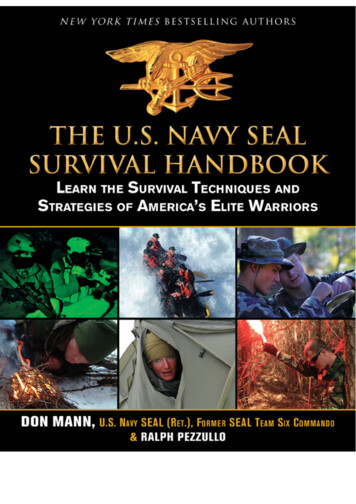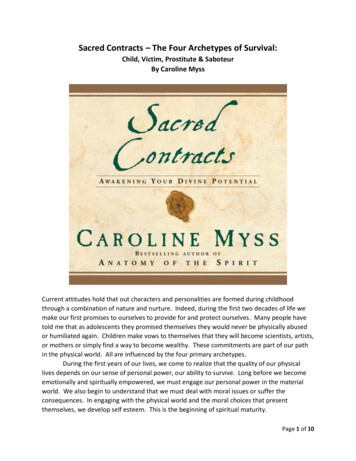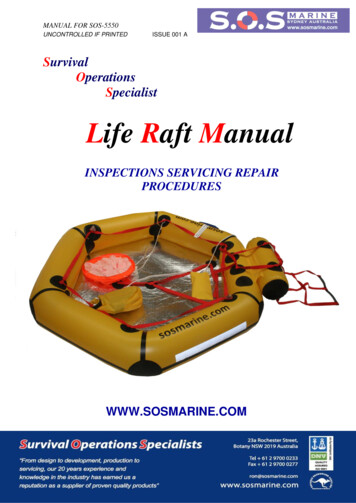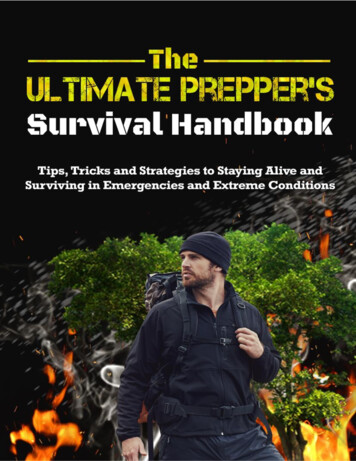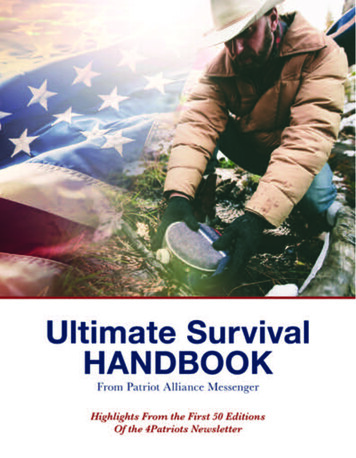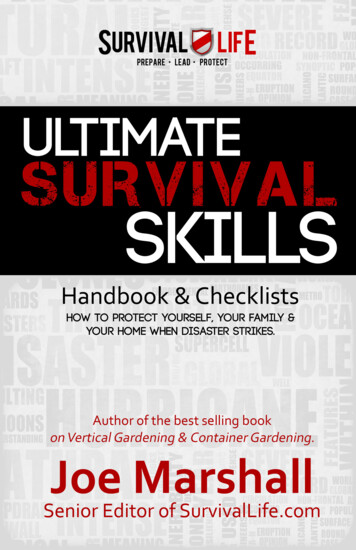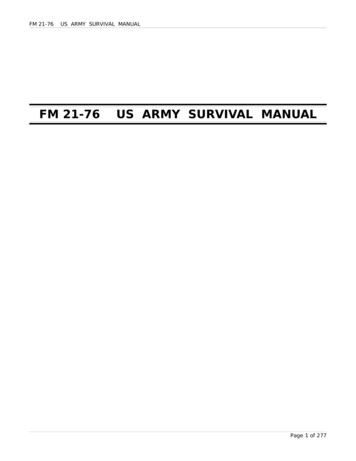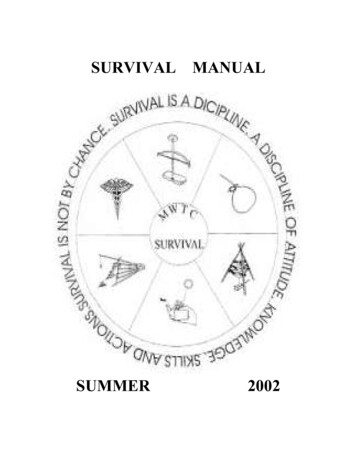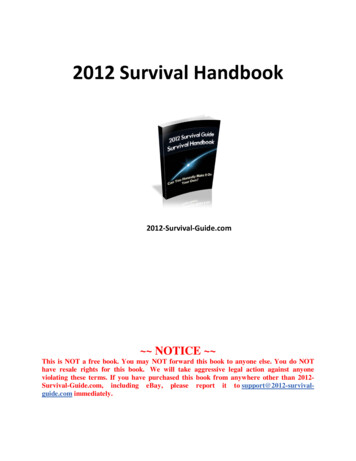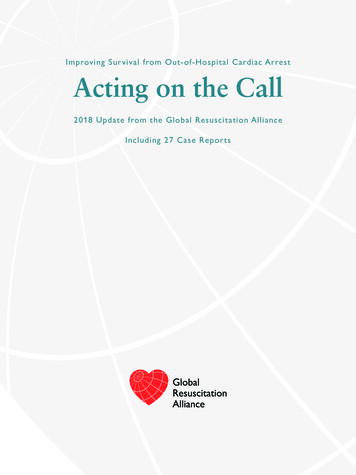
Transcription
Improving Sur vival from Out-of-Hospital Cardiac ArrestActing on the Call2018 Update from the Global Resuscitation AllianceIncluding 27 Case Reports
Improving Survival from Out-of-Hospital Cardiac ArrestActing on the CallThis document calls for action to improve survival from out-of-hospital cardiac arrest.Two facts stand out. Survival is low across communities and countries, often in the singleThe Global Resuscitation Alliance was proposed at a meetingdigits. Survival is disparate with 15 fold differences between high performing communitieson how to implement best practices in community resuscitation heldand poorly performing communities. It is an unacceptable reality that where a person livesin the Utstein Abbey near Stavanger, Norway on June 6-7, 2015.determines if he lives. We know that best resuscitation practices can achieve survival rates ofover 50% from ventricular fibrillation cardiac arrest. The GRA calls upon all communitiesThe attendees unanimously supported the creation of a Global Resuscitation Alliance (GRA)and issued a report, “Improving Survival from Out-of-Hospital Cardiac Arrest: A Call toEstablish a Global Resuscitation Alliance”. The GRA was formally launched at a follow upUtstein Meeting held in connection with the EMS2016 Conference in Copenhagen on May28-29, 2016. The following year the GRA at the EMS2017 Conference held on May 20-21to implement best resuscitation practices and afford every person a decent chance to survivecardiac arrest.This document will be updated periodically to reflect evolving best practices and new knowledge on how best to implement successful resuscitation programs.in Copenhagen the GRA requested an update to the original “A Call to Establish .”.This report updates the original report and has a new title reflecting the countless actionsand global engagement leading toward improvement in cardiac arrest survival.The new title is "Acting on the Call."April, 2018Authors:Mickey Eisenberg,Freddy K. Lippert,Director, Medical Quality Improvement, King County EMS, USAChief Executive Director, Emergency Medical ServicesCopenhagen, DenmarkMaaret Castren,Head of Department of Emergency Medicine and Services,Helsinki University Hospital, FinlandFionna Moore,CEO, London Ambulance Service, UKMarcus Ong,Medical Director, Prehospital Emergency Care,Ministry of Health, SingaporeTom Rea,Medical Director, King County EMS, USAPetter Andreas Steen, Prof. Emeritus, University of Oslo, NorwayImproving Sur vival from Out-of-Hospital Cardiac Ar rest:Improving Sur vival from Out-of-Hospital Cardiac Ar restTony Walker,Acting CEO, Victoria Ambulance Service AustraliaSang Do Shin,Medical Director of Seoul Metropolitan Fire DepartmentWith contributions from the following individuals:Acting on the Call,Global Resuscitation Alliance Update 2018A Call to Establisha Global ResuscitationAllianceIncluding 27 Case ReportsCall to Action 2016Acting on the Call 2018The goal of the Global Resusitation Alliance is to help increase globalsurvival rates by 50% from 2015 to 20202Alexander Elgin White, Sen. Executive, Unit forPrehospital Emergency Care, SingaporeAnders Hede, Head of Research, TrygfondenDenmarkAnn Doll, Exec. Director, Resuscitation Academy,USABrian Eigel, Senior VP of Emergency Cardiovascular Care (ECC)Conrad A. Bjoershol, SAFER Simulation andResearch Center, Stavanger, NorwayDavid Waters, Chief Executive of AmbulanceNew ZealandDouglas Chamberlain, Advisor to SussexAmbulance Service, UKEldar Soreide, Medical Director of SAFERFoundation, Stavanger, NorwayFredrik Folke, Head of research center,Emergency Medical Services Copenhagen,DenmarkGrethe Thomas, Project Director, TrygfondenDenmarkHideharu Tanaka, Chairman and Director ofTokyo EMS SystemJames Ward, Medical Director of the ScottishAmbulance ServiceJan Thorsten Gräsner, Med Dir., EmergencyMedicine, Univ. Of Schleswig Holstein, GermanyJo Kramer-Johansen, Prof., NorwegianNational Advisory Unit for EMS, NorwayHelge Myklebust, Dir. of Research, LaerdalMedical, NorwayJohan Herlitz, Prof. of Prehospital Care, EditorSwedish CPR Registry, SwedenJohn Freese, Dir. of Prehospital Research FireDept. of New York, USAJohn Meiners, Exec. VP ECC Programs AmericanHeart Association, USAJudy O’Sullivan, Dir. of Services and ClinicalLead, British Heart Foundation, UKMatthew Huei-Ming Ma, Professor of EmergencyMedicine, National Taiwan UniversityMichael Sayre, Medical Director for Medic One,Seattle Fire DepartmentNg Yih Yng, Chief medical officer, Singapore CivilDefence ForcePaul Gowens, Lead, Scottish Government out-ofhospital cardiac arrest program, UKPeter Kudenchuk, Medical Director for SouthKing County Medic OneTore Laerdal, Executive Director,Laerdal Foundation, Norway3
Improving Survival from Out-of-Hospital Cardiac ArrestActing on the CallCase ReportsTable of ContentsExecutive Summary. p 51.Tripling of survival in Denmark.20Preface. p 72.The European Restart a Heart day goes global.21Part 1. Cardiac Arrest in the Community. p 93.How to resuscitate a cardiac arrest registry (Norway).25Part 2. Global Resuscitation Alliance. p 144.Measuring the quality of life of OHCA survivors (Melbourne, Australia).26Part 3. 10 Steps to Improve Community Survival Rates. p 215.The South Australian Ambulance Service cardiac arrest registry.276Part 4. 10 Actions to Achieve Implementation. p 466.Using OHCA registry data to inform and monitor operational initiativesPart 5. Conclusion. p 53Part 6. Appendix. p 54and Government funding decisions (Melbourne, Australia).297.Tripling of survival in Japan over 10 years.338.Telephone CPR program recommendationsand performance measures (USA).349.Improving bystander CPR with dispatcher assisted CPR(Seoul, South Korea).3810.Telephone CPR in Arizona, USA . 3811.Telephone CPR in Singapore .3912.Telephone CPR with ongoing training and QI(capitol Territory, Australia).40413.Improve EMS CPR in King County with high-performance CPR.4314.The big problem in the big apple (New York, USA).4415.Police defibrillation in King County (Washington, USA).4816.Reducing response time and time to defibrillation (Melbourne, Australia).4917.Would you DARE to save a life (Singapore).5118.Verified responder (several US communities).5219.Restart a heart campaign in King County (Washington, USA).5320.Saving 200 more lives from OHCA in Norway .5421.Improving OHCA patient by empowering first responders (Belgium).5522.Well underway to training 5 million in CPR in the UK by 2020 (UK).5823.School CPR is gaining momentum.5924.Emergency Response at major sport events in Japan.6025.Increasing survival from OHCA in New Zealand.6126.Impressive increases in survival (multiple countries).6527.Increasing OHCA survival in developing EMS systems.725
Improving Survival from Out-of-Hospital Cardiac ArrestActing on the CallActing on the Call - Executive SummaryTimely application of several critical interventions determines the outcome fromcardiac arrest and is shown in Table 1. In cardiac arrest the likelihood of survivingdeclines by approximately 10% for every minute. Thus the intervals from collapseto application of key interventions largely determine the likelihood of survival.These interventions include rapid dispatch, telephone cardiopulmonary resuscitation(T-CPR) (for purposes of this table we consider bystander CPR by trained citizensto be synonymous with T-CPR), EMS at scene, EMS with patient to begin CPR anddefibrillation, provision of high performance CPR ( HP-CPR), and an aspirationalintervention of bystander defibrillation. The time and quality of these interventionsdefine poor, average, and best performing EMS systems.On June 6-7, 2015 at the Utstein Abbey near Stavanger, Norway, 36 EmergencyMedical Services (EMS) leaders, researchers, and experts from throughout the worldconvened to address the challenge of how to increase community cardiac arrest survival and how to achieve implementation of best practices and worthwhile programs.The attendees called for the establishment of a Global Resuscitation Alliance (GRA)and issued a report laying out ten programs to improve survival and ten steps toachieve successful implementation. The Global Resuscitation Alliance (formallyestablished in 2016 at the EMS2016 Conference) expands internationally the reachand utility of the Resuscitation Academy concept developed in King County, Seattle since 2008. Such a global effort will promote best practices and offer help withimplementation to countless communitiesPoorly performing EMS systems with approximate survival of 10% do not haverapid dispatch, telephone CPR, or HP-CPR. Time to defibrillation is 10 minutes withno or little bystander CPR. Average systems also do not have rapid dispatch but theydo have T-CPR (albeit delayed) and HP-CPR. Average survival is 30%. EMS systemswith best practices have rapid dispatch, quick deliver of T-CPR instructions, andHP-CPR. Survival is 50%. We believe that defibrillation by a bystander within 21/2minutes is a future reality and thus we call this intervention aspirational. Though nota reality today, technology for inexpensive consumer AEDs is close at hand. Whenthese consumer AEDs disseminate into homes and apartments, the opportunity forvery rapid defibrillation and survival rates of 75% can become a reality.Survival from Sudden Cardiac Arrest (SCA) is tragically and unacceptably low.Furthermore, there is 15 fold disparity is survival from ventricular fibrillation cardiacarrest. High-performance communities consistently achieve survival greater than50%. An estimated 1 million persons die every year from cardiac arrest in high-resource countries. This call to action declares the current situation to be unacceptable.We believe:- communities can and must do better.- based upon current knowledge that with adherence to and implementation of bestpractices communities can increase survival from cardiac arrest by 50%.- the Global Resuscitation Alliance will help educate EMS leaders about bestpractices and provide tools to help improve survival in their communities.StepsActions Form a team Cardiac arrest registry Telephone CPR Select programs High performance CPR Plan implementationstrategy Rapid dispatch Measurement ofprofessional resuscitation AED program forfirst respondersSystem factors influencing survival from out-of-hospital cardiac arrest Set specific goalsImprovedSurvival Achieve buy-in Establish standardsForm a team Consult experts Mandatory trainingfor CPR and AED Communicateprogress Accountability Support, advocate,celebrate Culture of excellenceCurrent situationFuturePoorAverageBestAspirationDispatch activated2211Ambulance r defibrillationnonono2.5EMS at scene7766EMS at patient site8.58.57.57.5EMS CPR started8.58.5--EMS HP-CPR startednono7.5as neededEMS defibrillation10109as needed10%25%50%75%(in minutes from cardiac arrest)Select programsPlan implementation strategySet specific goalsAchieve buy-inEstablish standards Pilot the program Smart technologiesfor CPR and AEDEMS System PerformancePilot the programConsult expertsCommunicate progressSupport, advocate celebrateSurvival (from VF/VT)The figure summarizes best practice steps and actions described in this report67
Improving Survival from Out-of-Hospital Cardiac ArrestHistorical PerspectiveIn 1990 at the historic Utstein Abbey near Stavanger, Norway, 36 researchers andEmergency Medical Service (EMS) program and medical directors gathered to solvea problem. There was lack of data about cardiac arrest survival, and in the fewcommunities that attempted to measure their performance there was a multiplicityof case definitions with no consistency in calculating survival rates. In short, therewere insufficient data and no agreement among the data elements. Those gatheredrecognized that programmatic advances in cardiac arrest and resuscitation wouldnot progress
Survival from Sudden Cardiac Arrest (SCA) is tragically and unacceptably low. Furthermore, there is 15 fold disparity is survival from ventricular fibrillation cardiac arrest. High-performance communities consistently achieve survival greater than 50%. An estimated 1 million persons die every year from cardiac arrest in high-re- source countries. This call to action declares the current .


